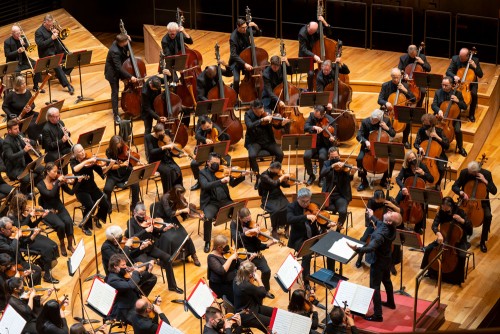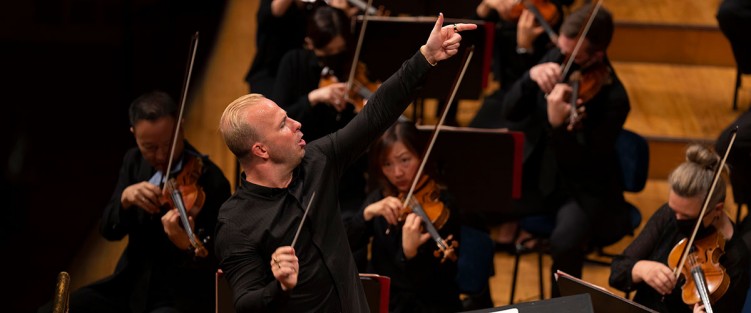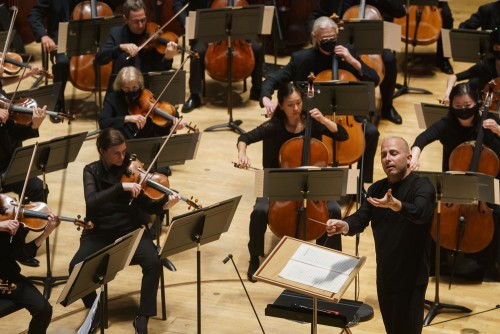“It’s time” I rumble (fussing with the shirt studs and cufflinks) “once again” (muttering while untwisting the back strap on my white vest) “to carp and whine about this ridiculously outmoded uniform requirement!”
The occasion? Getting set to join my colleagues in the Hamilton Philharmonic, a fine regional orchestra where I am sometimes called as a substitute. We are to perform music by Mozart, who wrote his beloved Symphony No.40 in G Minor before white tie and tails were a thing, and Richard Strauss, who lived during their rise as formal evening wear.
By the time I have finished tying my white tie, a sullen recognition has somewhat overtaken my inner protestations: tails are maybe just a tiny bit cool. While I dislike every bit of the hassle, I can’t deny that I feel a little suave, cultured enough to know how to knot my own white (but greying) bow tie, made of fabric similar to the impractical (and fraying) vest. Nobody should see this stuff up close, but we, like sheep, look nice from a distance. But the moment is short-lived.
What do tails really say? Do they say: “This art form is trapped in amber, its practitioners cling to tradition for their survival, the concert hall is a museum; the exhibits must never be updated.”? Or do they say: “We represent the élite, financial and cultural, we are up here, you aren’t.”? That’s what they say to me.
If I consult GQ, I am told why, when and what about the tails outfit. In an article published on Hallowe’en last year (imagine!) one learns that this mode of dress developed in the 19th century, roughly paralleling the rise of the romantic-era symphony orchestra and concert hall. The article makes no mention of orchestral concerts, but most certainly makes the case that white tie and tails is de rigueur for events like state dinners or, say, the Nobel Prize ceremony.
Workwear based on a century-old-plus model certainly matches staples of our repertoire, so we might be forgiven collectively for maintaining this image of social superiority, if it weren’t already so darned hard to maintain young audience’s interest. As a kid, I couldn’t have cared less what the players wore, it was the sound they produced that blew me away. If there’s any worth to what the symphony orchestra provides (a debate for a longer and more difficult article), it must be that the sounds and ideas we present belong to anyone who can hear or otherwise feel them. We benefit neither our craft nor society by distancing ourselves, or becoming living artifacts.
The management view: management typically argues that they want to present a uniform image (along with, one hopes, a quality product). Where I work (the orchestra pit for the National Ballet) it took a few years to convince head office that tuxes and/or black jackets for the men were unnecessarily hot, not to mention an odd priority when the visual component of the performance was entirely on stage. For symphony orchestras, performing in full view, the code tends to hold fast: the uniform is the uniform.
Except it isn’t: only a percentage of the band, those who identify as male, are required to dress in these anachronistic and often smelly layers. One or two members who present otherwise may opt in; nowadays likely no management would balk at a woman choosing to wear tails (although several groups seem still to forbid pants for women), yet should a man ask whether he might choose all-black while still presenting as male, he is likely to be subjected to insinuating cracks along the lines of “if you want to wear a dress or a blouse, go ahead…” And then of course comes the answer: “no.”
Once upon a time, women were only ever in the audience at orchestral concerts, and that “once upon a time” was not so long ago, when you consider some mid-European orchestras. The Berlin Philharmonic was mono-gendered until 1982, I read on Google’s ever-helpful answer page. The Vienna Philharmonic held out for masculine-presenting players until 1997. For gosh sakes, even the Boston Symphony had all-male membership until 1957. Looking for similar information about Canadian orchestras takes a bit more digging; it’s so un-Canadian to recognize that we were just as bound up in gendering opportunity away from women here as elsewhere. There are no doubt similar dates and slow-turning changes in the personnel make-up of most Western symphony orchestras. And that leaves aside the continued dismally poor reflection of human diversity many of our orchestras demonstrate to this day.
So while a “uniform” orchestra went out the window some time ago, the tradition of “tails for males” has been slow to follow. What tails really say is “looks are what matter,” and while I agree that one should be tidy on stage, presenting a uniform appearance to an audience can hardly be achieved by instructing one portion of the group to wear something elegant and fully black and another portion to keep on wearing that awkward and busy black-and-white ensemble known as tails. And for matinées, once upon a time, it was White Jacket; for some other types of shows, tuxedo and black tie. Honestly, whom are we trying to fool?
As far as I can discern from my fairly superficial reading of the facts, back in the day Orchestras were comprised of Men. Audiences were comprised of Men Wearing Tails (adhering to social uniformity of a different era), and Women Wearing Whatever Fashion Determined to be Classy. Men in the orchestra dressed to match the Men in the audience. Women in the orchestra was a contradiction in terms. I am not going to answer for my reductiveness in the service of humour, but I assume that people going to concerts today wear some version of what Women once wore. Maybe not, but feeling classy or at least “put together” in public is something many of us aspire to.
 The turning tide: It needs to be said that the tide is slowly turning, and some important ensembles have moved to the “elegant black” model, notably the Philadelphia Orchestra, elegant black since 2021. In some instances players are allowed to perform in casual wear. While I assume the management of any decent-sized orchestra today would hesitate to allow players to match the random sartorial choices in the hall, they could at least, with good sense, allow the players equal leeway to determine whatever elegant black might mean. It won’t be uniform. Hallelujah and amen.
The turning tide: It needs to be said that the tide is slowly turning, and some important ensembles have moved to the “elegant black” model, notably the Philadelphia Orchestra, elegant black since 2021. In some instances players are allowed to perform in casual wear. While I assume the management of any decent-sized orchestra today would hesitate to allow players to match the random sartorial choices in the hall, they could at least, with good sense, allow the players equal leeway to determine whatever elegant black might mean. It won’t be uniform. Hallelujah and amen.
Finally, is there anything that screams colonialism louder than hewing to the Middle-European, Dominant Colonialist culture, as we set ourselves on this pedestal of dress from the 19th century? Our organizations are more and more required to up their game on diversity, on representation of the under-represented, and exploration of what makes our art-form current and relevant. Let’s just, as a footnote to that very important and necessary work, ditch the tails.
Max Christie is a Toronto-based musician and writer. He performs on principal clarinet of the National Ballet Orchestra when restrictions allow, and otherwise spends too much time on Twitter / X.





